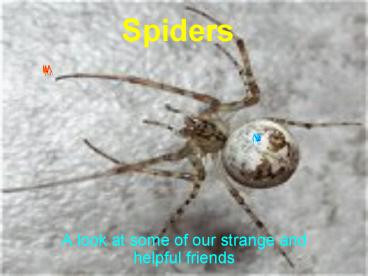Spiders - PowerPoint PPT Presentation
1 / 27
Title:
Spiders
Description:
Spiders are arachnids (and not insects); they are related to scorpions and ticks. ... Daddy-long-legs eat insects and worms, and some kinds also eat fungi and rotting ... – PowerPoint PPT presentation
Number of Views:281
Avg rating:3.0/5.0
Title: Spiders
1
Spiders
- A look at some of our strange and helpful friends
2
Spider Facts
- There are many different types of spiders that
live all over the Earth in practically every type
of habitat. They come in colors including black,
brown, white, gray, red, yellow, green, and
orange. Most spiders live for about a year, but
the tarantula can live for 15 years. Spiders
range in size from barely visible to many inches
across. Spiders are arachnids (and not insects)
they are related to scorpions and ticks. Young
spiders are often cannibals (they will eat each
other), and females often eat the male after
mating. Spiders are carnivores (meat-eaters)
most eat insects (like moths and crickets), but
the larger spiders, like tarantulas, will eat
many other small animals. - Webs Spiders produce silk in abdominal glands
(called spinnerets). Spiders use silk to make
webs and traps (for catching prey), shelter, life
lines, cocoons, and diving bells (for those
spiders who hunt underwater). The tips of the
spider's legs are oily this oil keeps them from
getting trapped in their own webs. Weight for
weight, spider's silk is stronger than steel.
3
Spider Anatomy and Life Cycle
- Anatomy All spiders have eight legs each leg
has 2 to 3 tiny claws at the end. They have a
two-part body and strong jaws (usually with
poisonous fangs). They have a hard exoskeleton
and not an internal skeleton. - Life Cycle After mating with a male, the female
spider produces an egg sac that can contain up to
a thousand tiny spider eggs. The egg sac is made
of silk, and the color varies from species to
species. In some species, the female spider
carries the egg sac on her spinnerets or in her
jaws until the eggs hatch. In other species, the
egg sac is hidden under a rock, attached to a
plant stalk, or encased in a web. Tiny
spiderlings (baby spiders) hatch from the eggs -
they look like tiny versions of an adult spider.
Some spiderlings are on their own and receive no
care from their mother. Other spiders climb onto
their mother's back after hatching, where she
feeds them. In some species, the mother dies when
the young are ready to go off on their own, and
the spiderlings eat her carcass.
4
(No Transcript)
5
Spider Anatomy
6
Spider Anatomy Definitions
7
Label the Spider Body Parts
8
Daddy Long Legs
- Close, but No SpiderA Daddy-long-legs isnt a
spider, though it looks a lot like one. It
doesnt have a waist between its front body part
and its abdomen. Its legs are longer and thinner
than a spiders, and it carries its body hung
low. Daddy-long-legs eat insects and worms, and
some kinds also eat fungi and rotting fruit.
9
(No Transcript)
10
(No Transcript)
11
(No Transcript)
12
(No Transcript)
13
(No Transcript)
14
(No Transcript)
15
(No Transcript)
16
(No Transcript)
17
(No Transcript)
18
(No Transcript)
19
(No Transcript)
20
(No Transcript)
21
(No Transcript)
22
(No Transcript)
23
(No Transcript)
24
(No Transcript)
25
(No Transcript)
26
(No Transcript)
27
(No Transcript)































